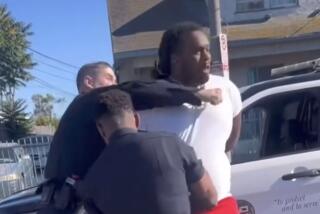Op-Ed: L.A. learned the folly of blunt response to crime
- Share via
When Bernard C. Parks was named chief of the Los Angeles Police Department in 1997, he was asked whether it was fair to judge a chief’s performance by the level of crime in his city. Never one to flinch, Parks responded that if crime increases, “the chief of police hasn’t done a good job.”
Chief Charlie Beck isn’t quoting Parks these days, as he and Mayor Eric Garcetti grapple with data that, for the first time in more than a decade, show crime — in every category except homicide — increasing across the city of Los Angeles. That’s an alarming turn of events, and yet it’s not one that should prompt city leaders to overreact.
It was not that long ago that conventional wisdom held crime to be a phenomenon outside police control. Academics, journalists and others looked to demographics, the economy, even the state of the family in attempts to explain why crime surged rapidly beginning in the 1960s and continuing through the 1980s.
Those trends were especially powerful in Los Angeles: A city with just a couple of hundred homicides a year in the early 1960s was transformed by violence in the 1980s. By 1991, more than 1,000 people were being killed annually; thousands more were victims of assault and tens of thousands were robbed, raped or otherwise brutalized. Street prostitution and drug sales were commonplace.
The LAPD response to that wave of violence made matters worse. Under the leadership of Chief Daryl F. Gates, the Police Department acted as a blunt instrument. Gates famously deployed an armored personnel carrier to batter down crack houses and unleashed neighborhood sweeps to round up suspects.
His personality didn’t help. Once asked why so many African Americans died after being placed in police choke holds, Gates answered that they did not respond the same as “normal people.” The remark stuck. Police took to referring to their cars, formerly known as “black and whites,” as “black and normals.”
Overwhelmed and poorly led, the LAPD retreated to reaction. Commanders accepted the idea that the department’s job was not to reduce crime but rather to apprehend criminals. “Protect and serve” became “respond and arrest.” Police were regarded as the enemy — an “invading army,” as they were called — in many minority communities. Finally, in 1992, the tension became too much. When a jury in Ventura County acquitted four LAPD officers of almost all charges in the beating of Rodney King, Los Angeles was plunged into the most devastating riots in modern American history.
But things changed. Beginning with Parks and continuing with his successor, Chief William Bratton, the LAPD began to target resources and respond strategically to crime. Bratton pioneered Compstat, a data-driven policing system he had employed as commissioner of the New York Police Department, and it soon debunked the conventional wisdom that police affected crime only at the margins. Guided by more precise information about levels and types of crime, police were able to forge intelligent responses, often in conjunction with other agencies and community groups, that addressed the causes of crime.
Much misunderstood in the popular media, Compstat isn’t mere data collection or a simple metric for assessing police effectiveness year to year; it’s the employment of data to understand communities and trends and stimulate discussion among officers and their leaders about how best to deal with problems. It’s a conversation and policy starter, not a finisher. And it works. Not perfectly and not in isolation, but over time and in the hands of thoughtful officials, it helps control crime and protect communities.
Here’s the evidence of that: Even with this recent uptick, Los Angeles today has about as much crime as it did in the late 1950s — though the city is more than twice the size — and has less property crime per capita than the national average.
The LAPD’s failure in the 1990s was to think bluntly — to see whole communities as criminal — and to react coarsely. As Gates bitterly learned, aggressive policing inflames a city rather than protecting it. It’s not possible to arrest enough people to thwart crime.
Data give police departments the opportunity to think more intelligently and to respond more subtly, but it, too, can drive overreaction. Confronted with statistics that show crime on the rise, it will be tempting for Chief Beck to prove he’s doing a good job by flooding neighborhoods with cops or rousting the homeless. That’s a temptation L.A. has learned to resist.
Jim Newton, a longtime reporter, editor and columnist for The Times, covered law enforcement in Los Angeles in the 1990s. He now edits Blueprint, a UCLA magazine devoted to the policy challenges facing California.
Follow the Opinion section on Twitter @latimesopinion and Facebook
More to Read
A cure for the common opinion
Get thought-provoking perspectives with our weekly newsletter.
You may occasionally receive promotional content from the Los Angeles Times.










